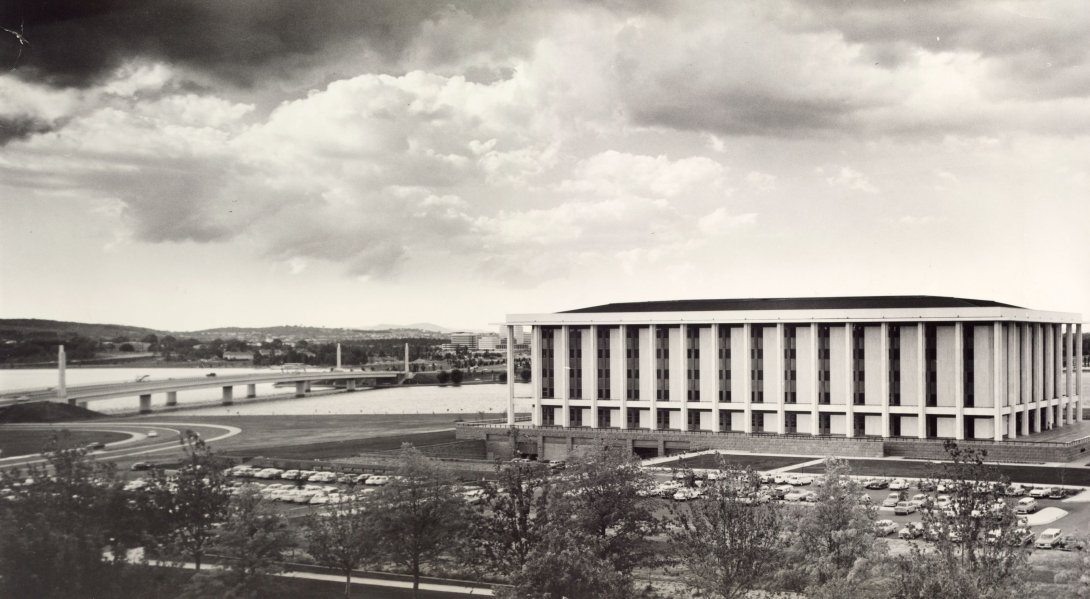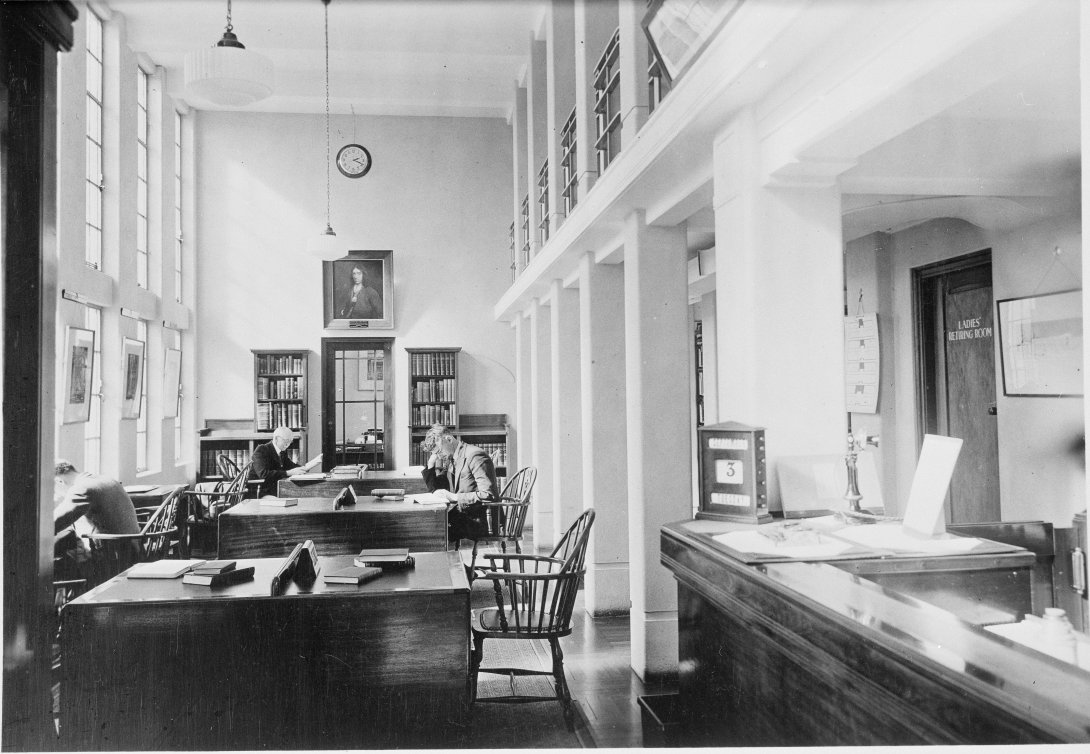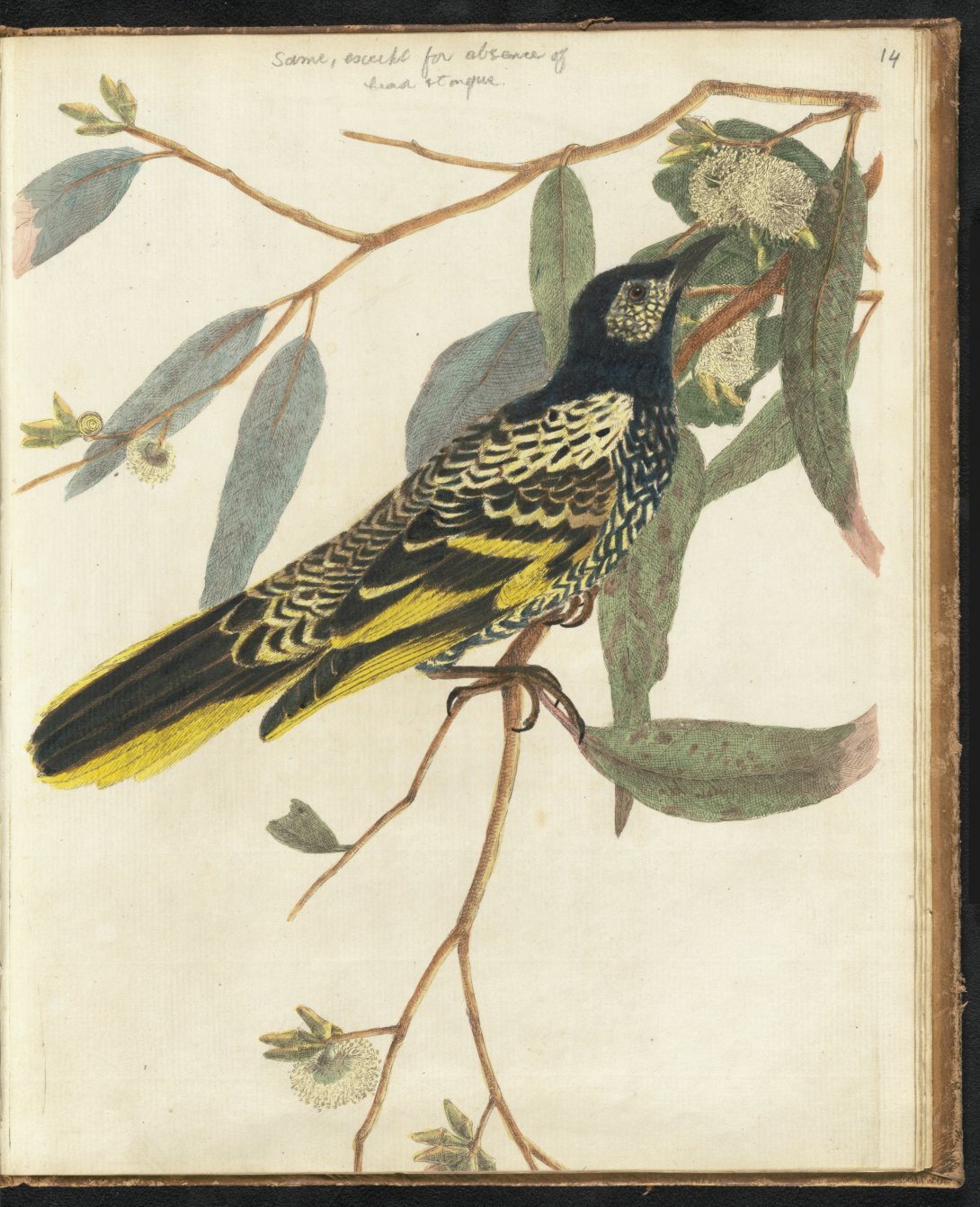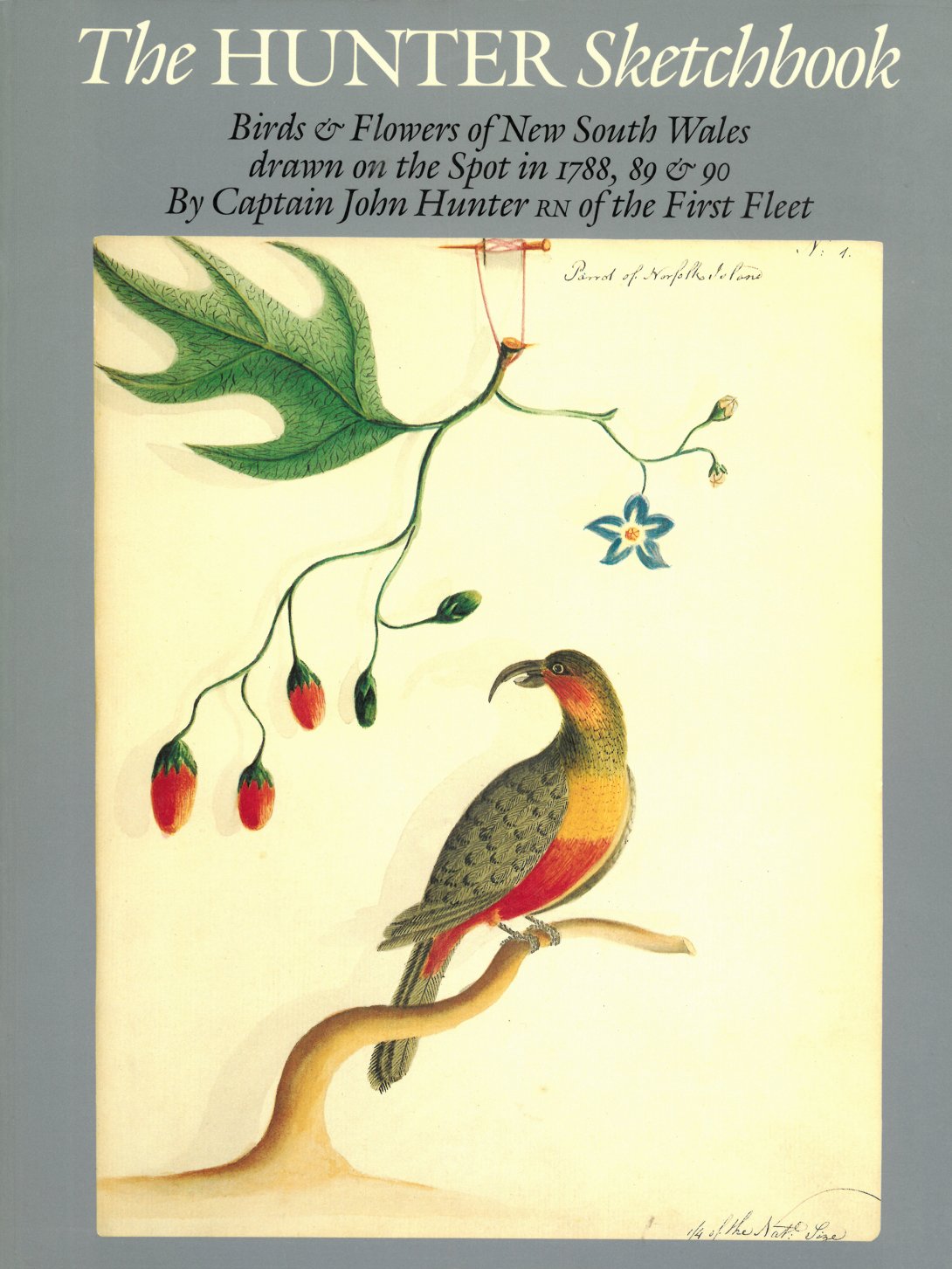By Michael Richards
Fifty years ago, beginning with its bibliographic publications, the National Library established a new publishing program led by its recently recruited head of publications, Alec Bolton. While the Library had been a publisher from well before its incorporation under the National Library Act 1960, and its bibliographic and historical publications had a long history going back almost to its beginnings, this marked an important stage in its development. My new biography of Alec, A Maker of Books: Alec Bolton and His Brindabella Press, is primarily about the books he published with his private press, but his role as the Library’s first publisher was also highly significant.
Between 1914 and 1925, in its earliest guise under the direction of the Library Committee of the Commonwealth Parliament, the Library had undertaken the ‘ambitious and difficult production of the first series of the Historical Records of Australia’ (Turnbull, 2001) a 26-volume compilation of documentary records beginning in 1788. From 1936, it had taken the lead in publishing an Australian National Bibliography with the Annual Catalogue of Australian Publications, and after the war the Library established the Australian Public Affairs Information Service, an index to Australian periodicals (Turnbull, 2001). Such projects as the massive Australian Joint Copying Project (1945–1997), which microfilmed material of Australian interest in British archives and in which the Library took the lead as ‘first among equals’, could also be considered as publishing of a sort, given the distribution of microfilm to partner libraries. Librarians across the country knew and relied on such resources, as did many scholars, but outside these worlds the National Library’s role and collections were little known to the majority of Australians. In 1971, the Library set out to change this (Bryan, 1991).

A new emphasis on publications was only one aspect of change in this period. In 1968, the Library acquired a striking new home, prominently located on the shores of Lake Burley Griffin and close to what was then anticipated would be the site of the future Australian Parliament House. The new building was the fruit of years of lobbying by Harold White (later Sir Harold), the first National Librarian (1960–1970), who served as Parliamentary Librarian between 1947 and 1967. After gaining statutory independence under the Act in 1960, the National Library had lost some of its previous wide-ranging functionality (it was no longer directly responsible for parliamentary library services), but its visibility on the ground in Canberra was enhanced under White. He had opted to move with the National Library to its new building, and, although he is often remembered primarily as a champion of collection building, he was also interested in Library outreach. The new building had space for exhibitions and displays when it opened, both in a series of imposing Tasmanian Blackwood showcases in its large foyer and on the lakeside mezzanine floor above the foyer. The showcases were still in use when I began working at the National Library in the 1980s, and I well remember how heavy some of the lids were to lift when we opened them to change displays! By then, though, our major exhibition venue was a substantial gallery on Lower Ground 1, next door to the Theatre. In 1992, the gallery was relocated to where it is now on the Ground Floor, displacing the old cataloguers’ workspace.

The Library’s new home was markedly different from its former premises, spread between a relatively modest building on Kings Avenue (opened in 1931 and known as the National Library long before it existed in statutory form); desperately overcrowded rooms at the Provisional Parliament House (now Old Parliament House); and various annexes. Prior to 1968, highly significant artworks, such as those in the Rex Nan Kivell Collection, had been barely visible—sometimes hung in parliamentary corridors closed to the general public, but often kept in crammed storerooms and difficult to retrieve. Some were even more off limits, in parliamentarians’ or staff offices. Famously, White himself had Tom Roberts’ 1918 painting Allegro con brio: Bourke Street West in his office at Parliament House and took it with him to the new building, although it at least was accessible if need be. Other artworks owned by the Commonwealth were loaned to state galleries or displayed in Australian missions overseas. A few were loaned to the Prime Minister’s Lodge. It would be several years after the establishment of the National Gallery of Australia before this latter practice ceased. The Gallery too gained its own act in 1975, although the Menzies Government had planned its establishment in 1965. It was opened by the Queen in 1982—mirroring the Library by the lake, with room between them for the Parliament House that would in the end be built elsewhere. The Library had few readers in its earlier buildings: a handful each day, apart from at the relatively busy Parliamentary Library. Now it had a large new building and much bigger public and specialist reading rooms. Alec Bolton’s remit was thus one aspect of a more general focus on outreach and greater visibility for the Library’s collections and services.
His brief also included improving the technical standard of its publishing. The general standard of government publishing was low at the time. As Frank Thompson put it, in the 1960s:
the federal government was receiving considerable public criticism over the poor design of its published material, the sometimes turgid and impenetrable bureaucratic prose, and the sheer inability of citizens to discover which department actually published what and, more importantly, where it could be obtained.
The Australian Government Publishing Service, incorporating the existing Government Printing Office, was created in 1970 to remedy this situation, but, as Thompson remarks, it was dominated by its printing personnel and struggled to behave like an entrepreneurial publisher. The National Library, along with some other government bodies, decided instead to develop its own expertise in-house, building on its long history as a publisher as well as the nationally significant material in its collections. Meanwhile, and in common with the rest of government, there were also new expectations about outreach as well as public access to information about the work of government. Agencies such as the Library were operating in a new environment, especially after the election of the Whitlam government at the end of 1972, which would include Freedom of Information legislation enacted in 1974. They would no longer report only to their minister and parliament, but to the people of Australia as well.
Coincidentally, in 1970 UNESCO had proclaimed 1972 would be International Book Year, choosing the theme of ‘Books for All’ for the year. One of Alec’s first tasks after his appointment in 1971 was to contribute to the development of a national travelling exhibition, Book Design in Australia, which was to be sent out to the state libraries. Publisher Sam Ure Smith contributed a brief foreword to the exhibition brochure, arguing that the development of a cadre of professional book designers meant that ‘standards of presentation have risen to a level that merges with standards prevailing in British, American and European book production’ (Smith, 1972). There were some fine books displayed, beginning with a historical section including John William Lewin’s Birds of New South Wales (1813) but also showcasing contemporary publishers such as F.W. Cheshire, Georgian House, the Melbourne branch of Oxford University Press, Sydney’s Edwards & Shaw, Ure Smith, Angus & Robertson and even one of Alec’s favourite private presses, Mary Quick’s Juniper Press of Burradoo. Clearly, there was an expectation that the Library’s new publications program would soon be of a similar standard—an unrealistic one, as Alec later observed:
The Library felt that it was sitting on vast treasures which ought to be shared with the public at large, and that was an invincible concept and I was expected to give form and substance to it.

Although, when he arrived, the Library was already publishing a range of bibliographical publications, ‘they were being produced to what I think everybody would agree was a very, very poor standard’. This included printing work sent out to local printers ‘whose work was pretty rough, and that’s really praising it’ (Bolton, 1996). At the same time, developments in the computer-based automation of publications such as the Australian National Bibliography offered opportunities for significant improvements in production. Alec would be intensely occupied for several years with the upgrading of these bibliographic publications, while also searching the Pictures collection for material suitable for reproduction as cards and in a popular series of annual themed desk diaries—there was a Library shop, but almost nothing to sell from it when he arrived. But it was books he was really interested in publishing, and he recalled that the chairman of the National Library Council at the time, Senator Sir Alister McMullin, was also urging him in this direction. (McMullin, President of the Senate from 1951 to 1973, had long been an ally of Harold White, supporting him earlier as well in establishing the Parliamentary Library’s trail-blazing Legislative Research Service (Connolly, 2012).
Alec found himself in a new and somewhat unusual position at the Library. It was very different from his previous working life, he later recalled:
when I was at the Library it always seemed to me that the world of commercial publishing, from which I had come, was like warfare being conducted by guerillas in a spirit of great competitiveness and anxiety and tension and conflict and drama, and the Public Service, by contrast, was like the ceremonial aspect of the Brigade of Guards. That’s how it seemed to me. It was a very different world. A strange world to get used to, and my position at the Library was an unusual one because I was really the one person, the one senior person at any rate, with responsibility in this field. All other people in the Library were very helpful to me and very nice to me, and I had a lot of friends (1996)
There were, it seems to me, four things that Alec’s work as a government publisher and his personal avocation as a private press printer had in common: elegant and well-considered book design; quality printing; punctilious editing; and a solid scholarly apparatus to accompany the collection material being published. All four are evident in such National Library of Australia titles as With Captain James Cook in the Antarctic and Pacific: The Private Journal of James Burney (1975), Letters of Vance and Nettie Palmer (1977), Cazneaux (1978), The Autobiography of John Shaw Neilson (1978), Augustus Earle Travel Artist (1980), Flower Paintings of Ellis Rowan (1982), The Challicum Sketch Book (1987) and The Hunter Sketchbook (1989). Most notable, perhaps, was The Bligh Notebook (1987), when the Library ventured for the first time into the world of the limited edition, but these principles are evident also in the bibliographic and statutory publications on Alec’s watch. This began almost immediately. The contrast between the Library’s Annual Report for 1970–1971 and that of the following year is striking; the first is a drab brown pamphlet illustrated by only one photo (of the council chairman) and with densely set pages, while the next is both well-printed and well-designed, with frequent illustrations of material from the Library’s collections and of Library activities. The cover features the floodlit Library building at night instead of the logo of previous years, which had been an intriguing but obscure representation by Douglas Annand of a gryphon holding a book – a reference to the Library’s location by Lake Burley Griffin, but of no immediately apparent meaning to most. (The next logo was an equally obscure vortex. It was not until 1991 that the Library reverted to the building itself as its avatar, as prefigured in 1972. [Bryan, 1991])

Other bibliographic publications of the period include the first of a series of handbooks to the collections of the Australian Joint Copying Project (1972-2005), initially published in association with the State Library of NSW, which would become fundamental resources for generations of librarians and scholars over subsequent years. Just as important to many reference librarians were the four invaluable ‘Burmester’ volumes: a Guide to the Collections of the National Library compiled by Clifford Burmester and published between 1974 and 1982. Undoubtedly the most elegant was French Plays 1701-1840 in the National Library of Australia (1973), a bibliography compiled by Ivan Page, then the senior rare books librarian at the Library.
Although it took some time to build up publishing momentum, as appropriate material in the Library’s collections was assessed, authors and editors were commissioned, and designers and printers found, by the time Alec retired from the Library 15 years later there was both a distinguished list in place and many works underway which had their origins in the Bolton era. Fifty years later, there is much to celebrate in the work Alec Bolton did as the National Library’s first publisher.
References
Paul Turnbull, ‘The Network and the Nation: The Development of National Bibliographical Resources’, in Peter Cochrane (ed.), Remarkable Occurrences: The National Library of Australia's First 100 Years 1901–2001, Canberra: National Library of Australia, p.258
Harrison Bryan, ‘The National Library of Australia: An Historical Perspective’, Australian Academic & Research Libraries, 22 (4), 1991, pp.163–179
Frank Thompson, ‘Case-Study: Government Publishing’, in Craig Munro and Robyn Sheahan-Bright (eds), Paper Empires: A History of the Book in Australia 1946–2005, St Lucia: University of Queensland Press, 2006, p.341
Sydney Ure Smith, Book Design in Australia, Canberra: National Library of Australia, 1972
Alec Bolton and Heather Rusden, Alec Bolton interviewed by Heather Rusden, 14 October 1996.
David Connolly, ‘McMullin, Sir Alister (1900–1984)’, Australian Dictionary of Biography, National Centre of Biography, Australian National University, published first in hardcopy 2012